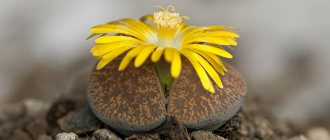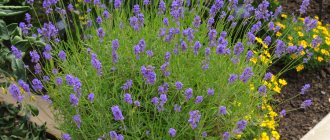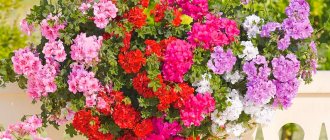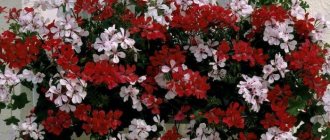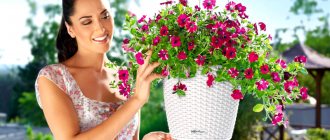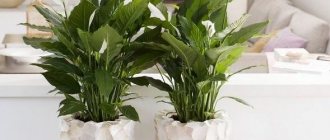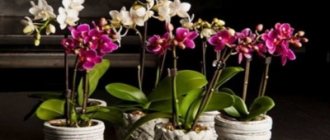When and how to plant petunia in pots outside?
Initially, you need to prepare the pots and sow the seeds. This is done at the end of February. It is necessary to mix the seeds with wet sand and place them on the ground. After this, the containers are covered with glass caps and wait for the sprouts to appear.
After this, the sprouts are thinned out; it is necessary that the distance between the sprouts be 5 cm. Next, you can sprinkle with a layer of damp soil. Water the plants from time to time and after a month you can replant them in pots. Containers with turf soil are suitable for this. Many gardeners recommend mixing hydrogel. This is silica gel that is pre-soaked in water. Introduce into the pot in a ratio of 1:5 with soil. This mixture retains moisture well and prevents root rot.
Planting instructions:
- Do not immediately take the plant outside. At the end of April and in May, night frosts are still possible. That is why flowers are gradually accustomed to lower temperatures.
- Maintain the temperature at +18 °C all week. Next, reduce to +15 °C. After this, place the plant on the balcony and monitor the temperature.
- Once the threat of frost has passed, you can move the plants outside or into the yard.
Planting in open ground is carried out on a cloudy day or after sunset. When exposed to direct sunlight, the leaves wither and the plant does not take root well.
When and how to plant petunia in pots outside?
How to make a pot yourself?
If the flowerpot is located in a warm room, then the most suitable material for it will be wood, plastic or ceramics. For the street, winter garden or unheated veranda, more frost-resistant options are suitable: fireclay clay or earthenware. If you grow petunia in pots, then you need trays to help out during the watering period. There should always be provision for water drainage.
You don't need a lot of money to create such a wonderful planter. Take an old wheel rim, pieces of ceramic tiles, glue, coconut base, primer and get to work
To be honest, it is not at all necessary to use this decorative device, but the aesthetic pleasure obtained with its help will never be superfluous.
You can completely make a decorative pot from start to finish from almost nothing. And the flowers will feel good in it, and without flowers it will become a real decoration of any area. This is our red flowerbed cat, the birth of which we will clearly demonstrate to you right now.
This cat is a real cutie. Everyone would like to have this on their property. And taking into account the fact that it also serves as a flowerpot, it has no price at all
For work, prepare:
- a large bottle made of thick plastic;
- cement, gypsum, water and sand;
- wire and wooden slats;
- sandpaper;
- paint and varnish.
The base of the flower garden will be a plastic bottle, but for this it will need to be cut. Cement mortar will be applied to the base. To prevent it from sliding on slippery plastic, you can tightly wrap it with wire. The frame should be knocked down from wooden slats, and then the prepared container should be tied to it.
If, when looking at the first photo, the final result is still difficult to predict, then over time the cat figurine will become more and more clearly realized. Don't forget about the water holes
Mix the solution at the rate of 1 part sand to 1 part cement. The consistency of thick sour cream is required. Under no circumstances should you add gypsum to the general solution, because it will instantly harden the mass. We put on rubber gloves. Take a handful of solution into your hand and add one tablespoon of gypsum to it. Knead the mass in your hands, form it into a sausage or ball and attach it to the frame, creating the shape of a figurine. We sculpt a face out of balls as if we were working with plasticine. Before placing small parts on the body, lubricate it with water.
You need to polish the surface of the figurine’s body with a hand dipped in water. The finished flower garden should not crack. To do this, it should be dried under cellophane for 3-4 days. On the first day of the drying process, it is better to moisten the figurine several times. Sand the surface of the finished cat with sandpaper. You can paint the cat using automotive or water-based paint or enamel. The finished figurine is varnished. This garden planter is resistant to severe frosts. If you take care of it and renew it, it can last a very long time.
It is very important not to over-hold the workpiece in your hands; you need to work quickly. As you can see, the result was not long in coming. To clearly understand the final goal, you can make a preliminary sketch
So our flowerpot is ready. Flowers placed in it will look just right on the cat’s back, especially if the overall color scheme is maintained.
What pots are best to plant petunias in?
The flowerpot is selected depending on your preferences. This is the basket in which the pot is placed. The basket itself is suspended and the flowers fall down. It is worth noting that you should not choose small flower pots, as there will not be enough space for the development of the root system. On average, pots with a diameter of 22 cm and a volume of 5 liters are chosen. This is enough for one plant.
What pots are best to plant petunias in?
What is picking and why is it needed?
Picking seedlings is transplanting them from a common container into separate containers while simultaneously pinching the roots of the sprouts. Most often, pinching is done 2/3 of the length of the spine. This procedure is necessary so that the roots of the sprouts can fully develop, receive a sufficient amount of nutrients and increase green mass.
Picking has a positive effect on seedlings:
- stopping the growth of seedlings if they have outgrown;
- removal of weakened, thin and frail sprouts;
- acceleration of the growth of the root system, thanks to the accelerated growth of lateral leaves and stems.
Picking not only stimulates the growth of the root system, but also increases the resistance of seedlings to negative weather conditions, diseases and pests.
Without picking, the growing roots of petunia seedlings will lack nutrients, being in cramped conditions. Growing seedlings block each other's sunlight and begin to stretch upward, becoming thinner and weaker.
The roots of the seedlings also suffer, as they have catastrophically little room to grow. It is these problems that picking petunia seedlings is designed to solve.
The best varieties of petunias for hanging flowerpots: list, names
Not all varieties are suitable for planting in pots. The pot itself implies that the plant will droop. Often such petunias are planted near arbors, and over time they entwine it. Arches braided with petunias look very nice. Ampelous petunias are chosen for growing in pots and flowerpots. They cascade down and have beautiful flowers.
The most popular varieties:
- Surfinia
- Pirate
- Rendula
- Avalanche
Please note that if you are planting flowers outside, you should limit watering and adjust for natural precipitation. If under a canopy, the plant needs daily watering.
The best varieties of petunias for hanging flowerpots: list, names
Features of the plant
The word ampelous comes from the German ampel - vase . All hanging plants are characterized by long creeping or drooping shoots. Ampelous petunia has the characteristic elongated shoots of such plants, up to 120 cm, with graceful bells of flowers, and is suitable for planting in hanging flowerpots or tall vases and boxes. It is also suitable for creating flower cover. One plant can cover up to 2 m of soil with a uniform carpet.
The peculiarity of ampelous petunias is that their stems point downward, in contrast to cascade petunias - in which the shoots first grow upward, then, having reached a certain length, grow downward. Otherwise, such petunias differ little from other species.
The color palette of ampelous petunias is quite wide: all shades of pink, purple, white, yellow and others. The size of the flowers of different varieties is also varied - from small to large, carnation-like (there is a lot of information about all varieties of begonia here).
There are also ampelous and semi-ampeloid petunias, which differ in the length of the shoots.
The difference between ampelous varieties of petunias and cascading varieties is described here.
Ampelous petunia: how many seedlings should be planted in a pot and at what distance from each other?
You can plant 2 petunias in a 10 liter pot. These plants have roots that grow well; they may not have enough space in the future. One plant should be planted in a small 5 liter pot.
It is worth understanding that such plants should be trimmed in time and dried flowers removed. Otherwise, the plant will begin to wither. In addition, the number of flowers may be reduced. As soon as you notice that the leaves and flowers are withering, cut off ¼ of the branches.
Ampelous petunia: how many seedlings should be planted in a pot and at what distance from each other?
Bush petunia: how many seedlings should I plant in a pot and at what distance from each other?
In general, this species is not grown in pots. Such plants are planted in the country, directly on open ground. The approximate distance between seedlings should be 20 cm. Accordingly, when growing this species in pots, one bush per container with a diameter of 20-30 cm is enough.
Bush petunia: how many seedlings should I plant in a pot and at what distance from each other?
Flower care
When growing at home all year round, it is important to provide petunias with optimal conditions :
- Lighting . In the warm season, petunia does not need additional lighting. It is enough to place it on the balcony or south/south-east window sill. In early spring and in the second half of autumn, seedlings require 16 hours of daylight. To compensate for the lack of light, phytolamps are used, which are placed at a distance of 20 cm from the plantings.
- Temperature . For adult petunia, the optimal value is +20°C. However, if it is hotter in the summer, this will not negatively affect the condition of the plant.
- Watering . Petunia is watered as the soil dries with warm, settled water at the root. It is important that the liquid does not get on the leaves. The plant does not like stagnant water. If you water too much, it starts to hurt. The soil is moistened in the morning or evening, when the sun is inactive.
- Feeding . Once every 2 weeks in summer, spring and autumn, fertilizing containing potassium and phosphorus (“Potassium Monophosphate”) is applied. A solution of chicken manure, ash, etc. is also used.
- Loosening . After each watering, the soil is loosened. This prevents moisture stagnation and contributes to the destruction of the earthen crust.
- Formation . To stimulate the formation of side shoots, pinch the central stem at the level of 4-6 leaves. If the plant continues to stretch, the pinching is repeated. During flowering, wilted inflorescences are removed.
Petunia needs to be cared for regularly. If the rules of care are violated, the flower begins to hurt . It is also attacked by various pests, such as spider mites.
Interesting things on the site:
How to grow indoor pomegranate: care features
How to plant an orange from a seed at home
Pot diameter 20 cm: how many petunias should I plant?
You should plant no more than two shoots in a large pot. In a pot with a diameter of 20 cm, it is enough to plant just one sprout. If you think that with a large number of sprouts you will get a lush bush, then you are mistaken. The roots of the plants will interfere with each other. Therefore, the optimal quantity is one bush. With proper care it will grow well and be lush.
Pot diameter 20 cm: how many petunias should I plant?

